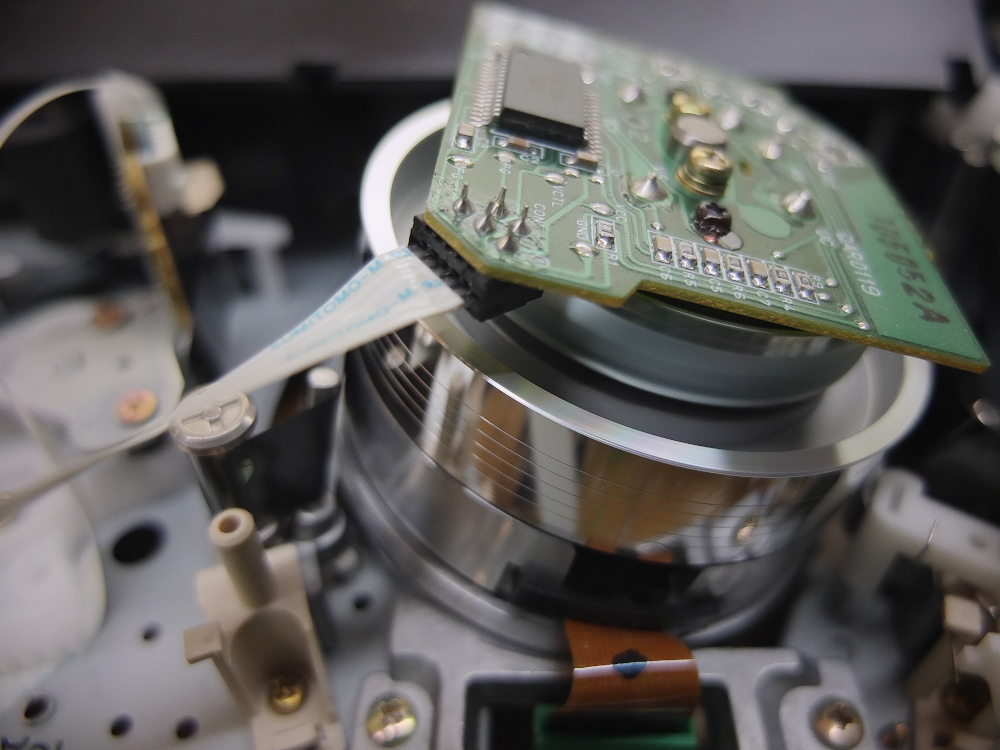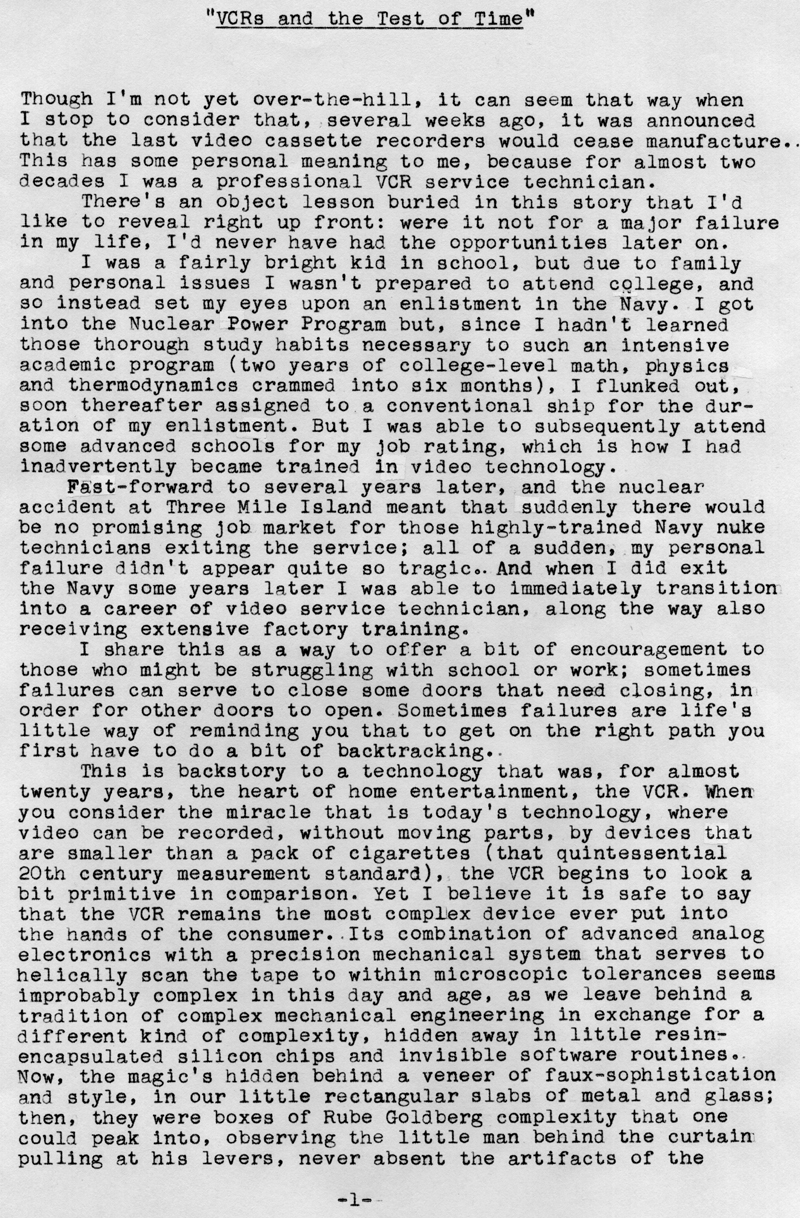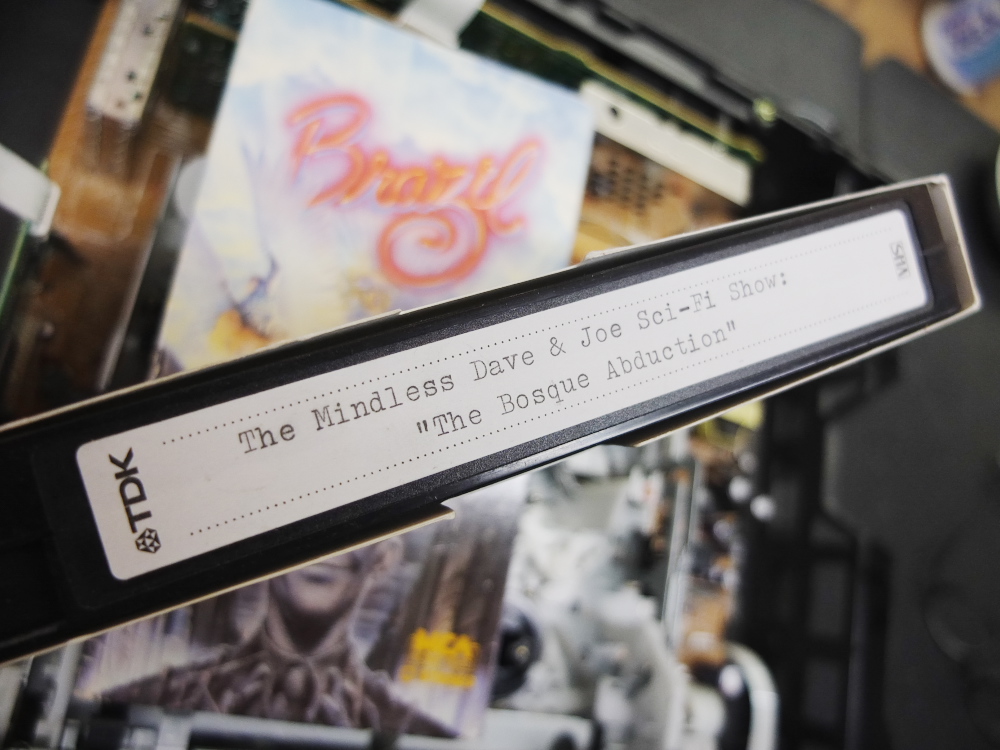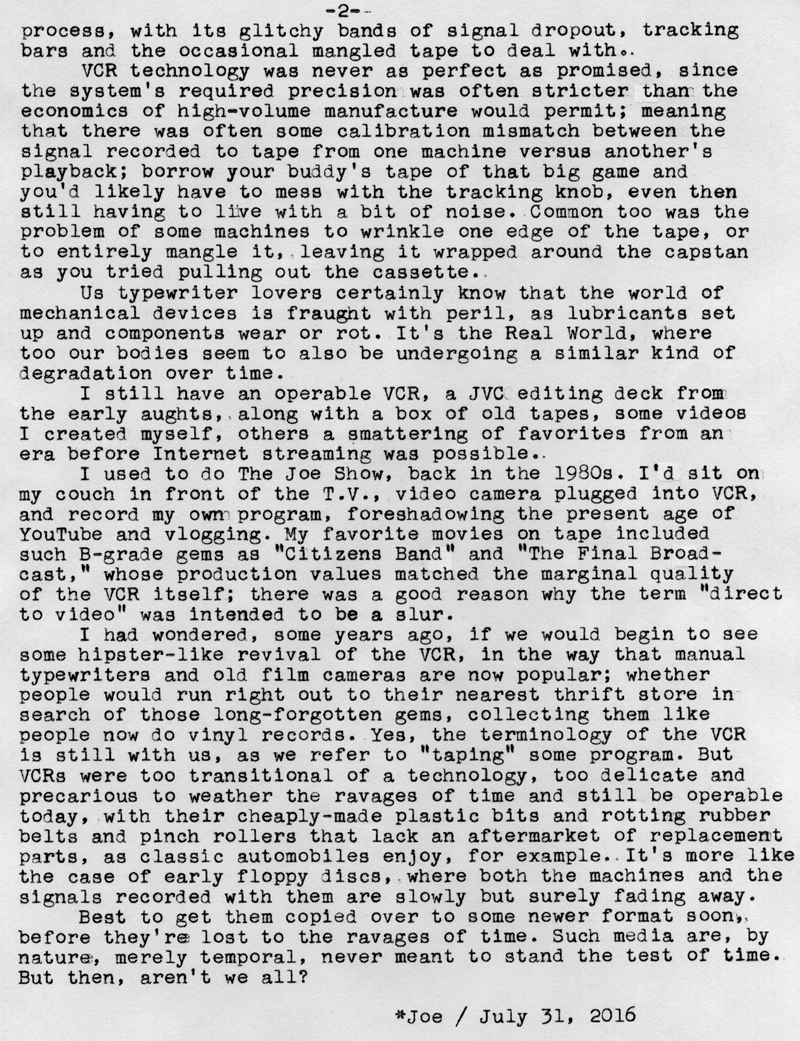VCRs and the Test of Time




Post-Script: There was a time when I was engaged in video editing strictly using analog video equipment, editing Hi8 video footage onto S-VHS. It was a fun process because one had to learn to time the back-roll of the recording deck, in order to get an accurate edit. The audio production was a bit more challenging, since only the low-quality linear audio tracks could be dubbed. I learned to compensate by using a Tascam 4-track cassette-based mixer for the sound production, edited ahead of time and rolled into the production as the video edit was progressing.
These days, the simple method I employ of iMovie on the iPad is so much easier; but I do look back upon those former days with fondness, as we learned to work around the limitations of our equipment.
I made a number of experimental videos throughout the '90s and into the aughts. And made a short movie with a buddy, "Bosque Abduction," wherein I star as the bad guy. Lots of fun.
Regarding the two movies mentioned in this piece, here's a link to Citizens Band (also known as Handle with Care), and The Last Broadcast.
In the early days of VHS and Betamax, before copy guard technology, it was possible to get a good copy of a laser disc movie onto video tape. Also, many films released to laser disc were unavailable on tape, and so copying was commonplace. Not that I would ever think about doing such a dastardly deed, but in our contemporary setting of digital audio protected by the DMCA (Digital Millennium Copyright Act), the lawyers would be running around in circles at the thought of someone copying audio via analog means, which is pretty much impossible to protect against.
I still see piles of VHS movie tapes in thrift stores, but rarely if ever consider purchasing any. Mostly it's because the titles available are of little interest to me; but also because playing someone's used tape is kind of like unprotected sex; you don't know if the tape was badly mangled at some point, which could clog or even destroy your deck's video heads; or if grease or other debris is on the tape, again presenting a danger to your equipment. This is especially important these days when you consider the gear is irreplaceable and unrepairable.
Oh, and in case you were wondering: yes, Betamax was superior to VHS. So there.
Photos via Fujifilm X10. Typecast via Corona Standard.
Labels: Corona Standard, Fujifilm X10, Hi8, memories, S-VHS, VCR

10 Comments:
This typecast struck a particular chord with me. Thank you for sharing so candidly. Kind regards,
I certainly have many memories of watching videotapes. And we still use the term "taping"!
Hipsters seem to be into music cassettes; maybe videotape isn't far behind.
I sure do see plenty of VCRs in seemingly newish shape at thrifts. they are a glut ten times worse than wedgie typers. :D
Joe - really enjoyed the post. I became more interested in the technology of the helical head when Alesis borrowed the technology to create one of the first digital machines for recording audio. That is to say, they used S-VHS tape to configure digital code onto the tape, using what we would now consider primitive ADC and DAC converters. The units were remarkably robust; until they weren't. Then, just as with a VCR, things could go horribly wrong, incredibly fast.
My jump away from linear tape to digital was a pleasant leap to no more broken tape, no more stretched tap, no more data shed, no more shuttling. True, digital had its own growing pains, but I trust a typewriter today to serve me just as well as it did when it was manufactured. Magnetic tape? Great technology to study (or reminisce about, but good riddance (IMHO).
Tom, your comment is great. I have an S-VHS tape around here somewhere recorded as a HiFi audio only (FM analog format) recording of KLSK 104.1FM from Santa Fe, back in the early 1990's, of the New Age music nationally syndicated program of Atmospheres, with great stuff like Tangerine Dream and Ottmar Leiber. Thanks for reading.
Hi, Joe -- Hooray for free-form KLSK! Back in high school I recorded a bunch of cassette tapes of labeled KLSK-1, KLSK-2, etc. (Still have them.) To this day, my serendipity-based MP3 playlists are named "KLSK Re-Imagined 1, 2, 3" etc. in their honor.
Do you remember KUNM doing free-form in the 80s too? On Thursday nights (I think) they used to broadcast the syndicated show "Totally Wired" showcasing electronic music, hosted by John DiLiberto and Kimberly Haas, who now produce Echoes (echoes.org).
One more fun factoid: one of the DJs on KUNM back then was Dwight Loop, who had a program called Earwaves. A few years ago he revived Earwaves as a channel on Soma.fm. So the good stuff is still out there!
Cheers,
Paul
Just discovered your blog through you YouTube channel. Great stuff! Maybe you can clear a question up for me that I have been unable to find a satisfactory answer for:
How can the helical scan head now when it is tracking correctly? A hard disc drive has half of the disc dedicated to doing exactly that with lightningly fast analog electronics adjusting the head continuously. The optical drives use a split laser and an optical sensor to know when it's drifting.
Does a video head do something similar on the tape? Could you priefly explain how it works or where to find out?
If I remember correctly a bog standard VHS tape has a raw digital data capacity of up to 50Gb. Not too bad. Comparable to a BluRay.
Great question.
VHS uses two servo systems, the capstan servo, which controls tape speed and phase, and the drum servo, which controls head speed and phase. There's a 30 Hz square wave control track recorded along the bottom edge of the tape, derived from the record signal's vertical sync.
In playback, the capstan (tape) speed is synced from the control track, and the phase is locked by comparing the control track's falling edge to the playback signal's vertical sync signal; there should be 3.5 horizontal lines of delay between the falling edge of the control track with the start of vertical sync, which is adjusted with a head switching circuit for the drum.
In playback, the drum servo speed (3600 rpm) is locked via a reference signal derived by dividing down the NTSC color oscillator (3.9545Mhz), while it's phase is also determined by comparing the falling edge of the control track with the playback signal's vertical sync.
Record is similar, but instead of the control track being the reference, the record signal's vertical sync is the reference.
Each video track is recorded diagonally on the tape, starting at the bottom (just above the control track) and ending near the top, just below the linear audio tracks. Each diagonal track is one field (256.5 horizontal lines) of video. Two adjacent tracks makes one video frame. A 30hz head switching pulse, derived from the control track in playback or the record signal's vertical sync in record mode, is used to switch the output amps between both heads, to get a seamless output signal.
The distance on the tape between the start of a video track and it's corresponding control track pulse was called the X-value, which, IIR, was about 11 inches. This distance was why, before flying erase heads appeared, dubbing a video signal onto a previous one meant a large gap of noise and snow. Flying erase heads erase a previous video track just prior to a new one being recorded on top.
The tracking control (manual in early machines, automatic in later) adjusted the drum phase servo, which essentially adjusted where along that diagonal track the heads would scan. Compatibility issues between two machines, caused by their respective tape paths not being exactly aligned to a common standard, meant that a signal recorded by one might not play back well on the other, because to the second machine's perspective the tracks are not exactly straight, but slightly curved, bottom or top, depending on which tape guide (entrance or exit side of the drum) was misaligned. You would have to adjust the tracking control to find a happy medium where it scanned most of the track properly.
So, if the bottom of the tape gets wrinkled, by a badly misaligned tape guide, it could affect the playback of the control track signal, which would in turn effect both capstan and drum servos. In playback, tape speed (SP, LP or SLP(EP)) is automatically detected by the frequency of the control track signal, which at the right speed should be 30 (actually 29.94) Hz.
(Note: JVC called the slow speed EP (extended play), while Matsushita (Panasonic's parent company) called it SLP (super long play), hence the difference in terminology between brands.)
VHS HiFi audio is an entire other subject. They use a separate set of heads on the drum, with a wider head gap, and record the FM modulated signal on diagonal tracks underneath the video tracks (deeper into the tape oxide layer). As such, HiFi audio couldn't be dubbed, without disturbing the video signal. Beta HiFi didn't need an extra set of heads, they could fit the FM audio signal in the spectrum of the RF envelope between the luminance carrier and the down-converted chroma.
A high-end VHS VCR would have up to 7 heads on the drum; 4 video heads (2 optimized for the SP speed and 2 for the EP (SLP) speed); 2 HiFi heads and one flying erase head.
Yea, that's probably too much information. What's amazing is that I can recall all this stuff, decades later.
Thank you! Well written and concise. You missed out on one crucial bit of information. I.E. the control track is read by a separate fixed head just like the standard audio. I was able to do a wiki lookup because you gave me the word "control track". ;-)
I fondly remember my first VCRs. Both were built in the early 80s and like tanks. Built to last and be repariable Beta machines. Later I bought a VHS simply because of the availability of VHS rentals. All 3 of those were monsters compared to what was out there in the 90s. Beta was much superior to even S-VHS. Beta broadcast was all we used at the TV station (and most TV stations) except for Ampex Quadraplex machines in the studios. Later we had some D1 or D2 machines. The Quadraplex was the forerunner of later technology that enabled the VCR to be made. Like broadcast audio tape cartridges I do not miss the VCR, but I do regret not copying many of my tapes over to DVD.
Post a Comment
<< Home